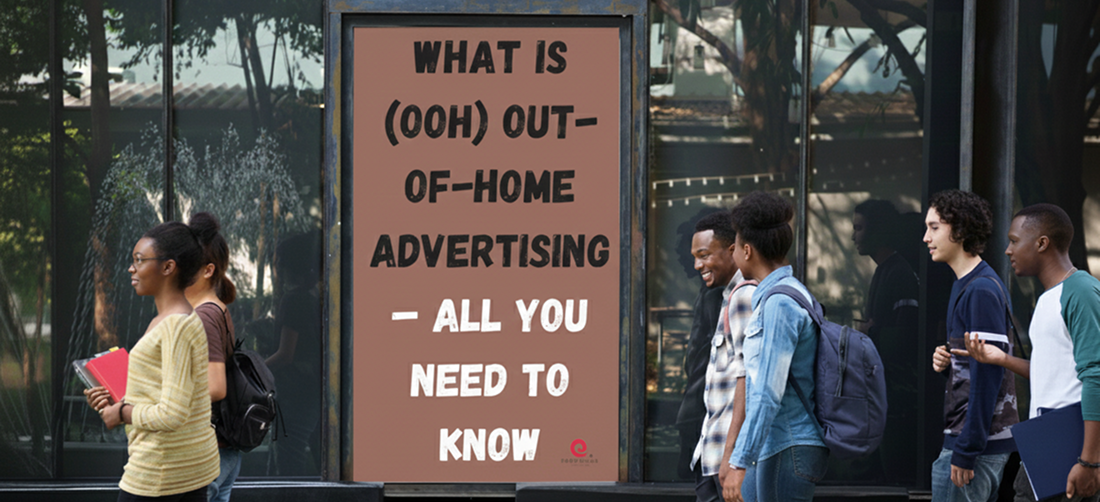Table of Content
- 1. What Is (OOH) Out-of-Home Advertising?
- 2. Understanding OOH Advertising: Core Concept
- 3. Types of OOH Advertising
- 4. Benefits of OOH Advertising for Brands
- 5. OOH Advertising in India: Growing Opportunities
- 6. How to Plan a Successful OOH Advertising Campaign
- 7. What Is an Example of OOH?
- 8. OOH Advertising vs Other Traditional Channels
- 9. Future of OOH: Data, Tech & DOOH
- 10. Conclusion
Out-of-home (OOH) advertising, often referred to as OOH out of home advertising, is one of the oldest yet most effective forms of marketing. In a world dominated by digital screens and social media feeds, OOH continues to make an impact by reaching people where they work, travel, and play. Whether it’s a massive billboard on a highway or an ad on a metro train, out-of-home advertising offers unique ways for brands to stay visible and top of mind.
In this blog, we’ll dive into what OOH marketing really means, its types, benefits, and why it’s still a valuable channel for brands, especially in a fast-growing market in India.
What Is (OOH) Out-of-Home Advertising? #Out-of-home-advertising
OOH advertising refers to all forms of advertising that reach consumers outside of their homes. Unlike digital ads that pop up on your devices, OOH campaigns are designed to engage people as they move through public spaces, from roadsides, airports, malls, to railway stations, and even elevators. The goal is simple: put your brand message in front of people as they go about their daily routines.
Unlike digital ads that are confined to screens or print ads that stay indoors, out-of-home advertising offers an always-on, high-visibility solution. From massive hoardings on expressways to creative installations in malls or airports, OOH engages audiences in physical environments where attention is often undivided.
Out-of-home marketing these days can vary from using static media, such as billboards, posters, and hoardings, to dynamic formats like digital displays and transit ads. Not to mention, one-of-a-kind, innovative billboards that agencies experiment with. It’s a powerful way for brands to drive awareness, reinforce messaging, and reach mass audiences in a non-intrusive manner.
Understanding OOH Advertising: Core Concept
At its core, OOH advertising is about visibility at scale. It leverages high-traffic locations to ensure brand messages are seen repeatedly, helping with both recall and trust-building. Unlike digital ads that can be skipped or blocked, OOH ads are part of the audience’s environment, unavoidable and memorable when done right.
The strength of OOH advertising lies in its ability to create unavoidable brand visibility. It doesn’t rely on users clicking, scrolling, or opting in. Instead, it becomes part of the public landscape.
OOH works on key principles:
- High frequency and reach: People pass by the same ads repeatedly, which builds familiarity and recall.
- Location-specific targeting: Ads can be strategically placed where target customers are most likely to be.
- Integration with the environment: OOH becomes a natural part of the urban or rural scenery.
Moreover, modern OOH integrates with digital tools like geofencing, mobile retargeting, and programmatic buying, making it more data-driven and measurable.
What sets OOH apart is its ability to reach a broad and diverse audience without requiring them to opt in. From busy urban centers to rural highways, out-of-home advertising ensures your brand is part of everyday life.
Types of OOH Advertising
There are various types of OOH advertising formats, each offering unique benefits depending on campaign goals and audience.
- Billboards & Hoardings: The most iconic form of OOH, billboards dominate highways and cityscapes, offering large-scale exposure.
- Transit Advertising: Ads placed on buses, trains, metro stations, and even auto rickshaws are perfect for targeting commuters.
- Street Furniture: Includes ads on bus shelters, benches, kiosks, and public utilities, blending into the urban infrastructure.
- Airport & Mall Advertising: Premium OOH spaces that engage affluent, high-intent audiences.
- Digital Out-of-Home (DOOH): Modern OOH formats that feature dynamic digital content, allowing brands to run interactive or time-sensitive campaigns.
- Ambient & Experiential OOH: Creative installations or pop-up displays that surprise or engage audiences, like branded vending machines, 3D hoardings, or interactive kiosks.
Benefits of OOH Advertising for Brands
OOH advertising offers several advantages that make it a vital part of an integrated marketing strategy:
- Mass Reach & High Impact: OOH ensures wide exposure across different demographics and geographies.
- Non-Skippable, Always On: OOH ads can’t be switched off, blocked, or skipped, making them ever-present.
- Enhances Brand Trust: Being visible in prominent public spaces signals credibility and stability.
- Complements Digital Campaigns: OOH can amplify online efforts by increasing brand recall and driving search/social engagement.
- Cost-Effective Reach: When planned well, OOH offers an affordable CPM (cost per thousand impressions) compared to some digital and traditional channels.
OOH Advertising in India: Growing Opportunities
OOH advertising in India is experiencing rapid evolution. According to industry reports (e.g., KPMG, EY-FICCI), India’s OOH market is growing steadily, driven by urbanization, infrastructure development, and the rise of smart cities.
Key trends fueling OOH advertising in India include:
- Expansion of metro networks and airports, creating new premium advertising spaces.
- Adoption of DOOH formats in major cities like Mumbai, Delhi, and Bangalore.
- Government initiatives like the Smart City Mission are increasing the inventory in public spaces.
- Tier 2 and Tier 3 cities offer untapped potential for regional and national brands.
With India’s mobile and digitally connected population, combining OOH with mobile retargeting offers even more innovative possibilities.
How to Plan a Successful OOH Advertising Campaign
For out-of-home marketing to deliver results, careful planning is essential. Here’s how to approach it:
- Define Goals: Awareness, reach, frequency, or hyperlocal targeting? Align your OOH objectives with your overall marketing goals.
- Know Your Audience: Study where your target customers live, work, and commute to choose the right locations.
- Select the Right Formats: Mix static and digital OOH depending on budget and creative needs.
- Get Creative: Design eye-catching, memorable visuals with a clear message and strong branding.
- Measure & Optimize: Leverage footfall data, mobile tracking, or QR codes to measure impact and refine future campaigns.
Working with a professional OOH advertising agency ensures you get the best inventory, pricing, and execution.
What Is an Example of OOH?
A classic example of OOH advertising is the towering billboards at Times Square, New York, or the vibrant hoardings along Mumbai’s Western Express Highway. Ads on Delhi Metro trains or bus shelters in Bangalore are everyday examples of how OOH keeps brands visible to millions.
OOH Advertising vs Other Traditional Channels
Compared to print, radio, or TV, OOH advertising offers:
- Better Location-Specific Targeting: You can place ads exactly where your audience is.
- Longer Exposure Time: People see OOH ads repeatedly during commutes or errands.
- Lower Ad Avoidance: Unlike TV, where people switch channels, OOH is hard to ignore.
- Cost Efficiency at Scale: For campaigns needing mass reach, OOH often delivers better CPMs than print or TV.
OOH pairs well with other channels, creating a 360-degree marketing strategy.
Future of OOH: Data, Tech & DOOH
The future of OOH is dynamic and data-driven. Digital Out-of-Home (DOOH) is revolutionizing the industry by enabling:
- Programmatic buying of OOH inventory.
- Real-time content updates based on weather, time of day, or audience demographics.
- Integration with mobile and geofencing technologies for better tracking and retargeting.
As technology advances, expect OOH to become smarter, more interactive, and even more effective at engaging audiences.
Conclusion
Out-of-home advertising remains a vital channel for brands seeking mass visibility and local relevance. Whether you’re targeting urban professionals in metros or consumers in smaller cities, out-of-home marketing offers unmatched reach, creative flexibility, and long-lasting impact.
With new technologies like DOOH, the future of OOH advertising looks brighter than ever. For brands aiming to make a mark, OOH continues to be an essential part of a balanced marketing mix, especially in a dynamic market like India.



